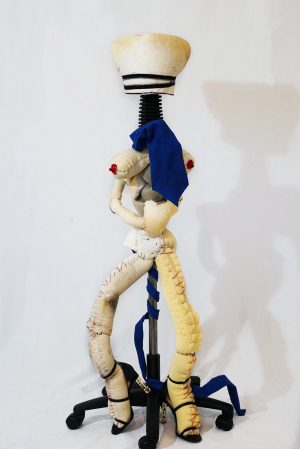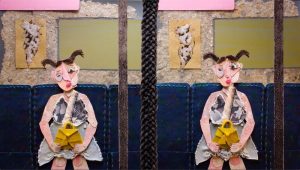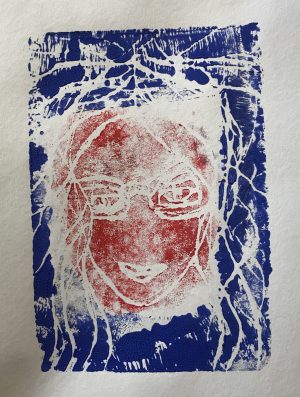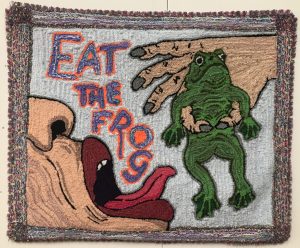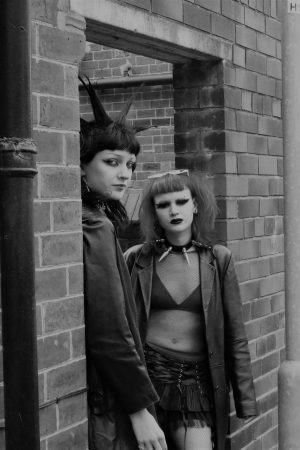Ever wondered why Alexa, Siri, Cortana or your dad’s old SATNAV have female voices?
Is there really gender bias in AI and robotics?
These are just a few of the questions and themes explored in artworks featured in The Manchester Open Exhibition 2022. For International Women’s Day 2022, we explore how 9 womxn and female identifying creatives are breaking the bias through art.
Exploring feminism, love and connection, physical appearance and identity, gender dynamics in the workplace and lived experiences, these artworks undoubtedly pose questions and start conversations around the female/womxn experience today.
So, how can art imagine a gender equal world?
According to Manchester Open 2022 submission data, approximately, 231 out of 446 artists identify as female.
With 4 out of the 5 Manchester Open Award winners being female, it’s great to see female and womxn artists represented and supported in Manchester’s art scene. Continue reading to explore our highlighted Manchester Open artists and creatives and their stories behind their work.
Annabelle Richmond-Wright
Alexa, deconstructed computer chair, hand-stitched foam, latex and found object, high heels (No. 469)
Manchester Open Award Winner – Castlefield Gallery: Artist Professional Development Award 2
“Alexa was inspired by my experience working as a digital marketing assistant at the first company I worked at, which was in a male-dominated industry and I was the only woman who worked there. 90% of my customers were male and my colleagues were male engineers and directors which automatically made me subject to sexist comments and being 20 years old I felt as though I was an object.
One time, the boss told me off for talking on the phone in a deep voice (I have a naturally lower-pitched voice) and instructed me to speak in a ‘nice feminine pitched voice’ (his words!) because that excites his male customers who want to picture a pretty young lady in their minds.
He genuinely said that and it disgusts me on so many levels for many different reasons.
Alexa was born out of my research into the history of women’s work where women were first employed into the corporate world as secretaries and typists during the wars to ultimately answer to their male counterparts who were paid much more and were working in the higher respected roles. This gender inequality was reinforced when I noticed that virtual assistant technology (Alexa, Siri, Cortana, your dad’s old TomTom SatNav) has a female voice/persona as a default setting and the fact that the male-dominated tech industry design and manufacture these products.”
- Instagram: @arw.art
- Website: https://www.annabellerichmondwright.com/
Faye Cooke
Touch, oil paint on wood (No. 245)
“This piece explores the concept of interracial relationships within the modern-day society. I created this piece to comment on my vulnerability towards my hair. Allowing my partner be apart of my experience with my afro Caribbean hair. This piece is about love and connection.
The concept of my piece is to challenge the stereotypes of being a strong Black woman. Within my painting I wanted to highlight the moment of vulnerability and expose the learnt insecurities about my hair.”
- Instagram is @F_Cookepaints
RYUJI GOTO
Hope for the Future – Faith in Young Torch Bearers, Mixed media/chalk paints, acrylic paints, oils and paper cuts painted on cotton canvas stretched wooden frame. (No.40)
“I am as a grandparent hard to stop feeling fear for the future for the young. But at the same time, I believe in the future a better place to live for the young and old if we help each other to create a community spirit and putting more faith in the young who are not afraid to take responsibility.
My interests toward creating this painting was initially the climate crisis, then power and the rights of the young through my faith belief. I have been always trying to learn from everyone I meet, and it is important that any relationship is based on mutual respect. I really value differences and diversity in any society, group and individual. Sense of total inclusivity is the key to all.
I figured the main character as a young woman holding a torch of hope in order to challenge the stereotypical leader figures. I am a grandfather aged 66, wanting to support the young who are not
afraid to take responsibility and courageously lead the way to the better future for everyone on this planet.
- Facebook : /PopUpTokyo
- Twitter : @PopUpTokyo
- Instagram: @goto_popuptokyo
Jessica Wheeler
Jaybirds, still from short stop frame animation film. (No,390)
“The film is seen through the eyes of the protagonist. It plays with the idea of animating an alternate reality, through a split screen. The protagonists’ reality is frustrating so she re-animates a version of it.
Two main images led to the making of Jaybirds, a scene from Chytilová’s ‘Daisies’ (1966) and an ‘essential toolkit for girls’ I saw in Wilko.
The film playfully deals with frustrations around gender, sexuality and expectation. Allowing a character to physically manipulate the frame in which they exist interested me and I wanted to develop this within the realms of animation, playing with traditional manipulation techniques. We watch through the eyes of the protagonist as she manipulates the images around her. She is irritated when a beautiful woman in a park is approached by a strange man, and so she decides to cut him into tiny pieces and inflate his dog.
The process focused a lot on the use of sensory materials. The first scene is made from raw materials; handmade paper, wool, grass, bits of bark from a beech tree. As the film develops, more artificial materials are introduced, until this unpleasant crescendo where the items in the frame start to manipulate her.
Some very talented female artists worked on this film, big shout out to Anna Pearson (animator) and Jennifer Walton (sound).”
- Visit Jessica’s website: https://www.jessicawheeler.co.uk
- Instagram: @dambalacraft
- Twitter: @JJ_WHEEL
Nazma Noor
Self Portrait, block print on card, (No. 204)
“I created this artwork during a group workshop where the theme was self portraits. We were each given a mirror, a sheet of polystyrene and a pencil to carve our own images into, then a selection of paints to make a print.
My artwork relates to this year’s IWD theme on valuing and celebrating difference.
At the in my life when I created this print, I’d been on quite a personal journey in regards to my self-image, being a British South Asian woman and stepping away from the western beauty standards I’d seen around me and had reinforced by my social circle. I began my portrait with the big waves of my hair, full of volume and filling much of the space. I wear my hair naturally curly most of the time now, and I can’t believe the 10+ years of my life I spent using hair straighteners. Even now, there are still people in my life, including close family, who wish I would straighten my hair, but I do as I please!
The other key part of the portrait that was important to me was that I was wearing glasses. I made the decision to ditch wearing contact lenses, which were causing discomfort and dryness in my eyes, and to embrace my “chic geek”. I spent a small fortune on a pair of designer specs and loved how I looked in these. There were many occasions where I could have chosen to wear lenses just for the day but I stood firm and I even wore my specs to the huge social function that was my big brother’s wedding.”
- Twitter: https://twitter.com/nazma_knows
Insta: https://www.instagram.com/nazma.knows/
Web: http://nazmaknows.co.uk/
Cookie Love
FEVER COAT, spoken word performance
“FEVER COAT” is a Spoken Word piece about my realizations as a black person living in Britain, the relationship I share with my mother and my lived experience. The poem is tied together with the metaphor of a Fever Coat; when kittens are born with white fur which eventually fades to black as they age. The white coat is due to the mother cat usually experiencing an ongoing illness or sickness during pregnancy.
In my opinion that sickness was the high expectation of subservience put upon the Windrush Generation and the limitations Black Women were and are still subjected to. I feel this impacted me to grow and step away from gender constructs overall, as I myself identity as non-binary.
The piece highlights the issues that through no fault of their own, that generation was just trying to prosper in a racist country and thusly contradictions and particular restrictions were put upon myself.
The poem, I dedicate to the two most important women in my life, my mother and grandmother. The pressures and obligations that women persistently endure are tough and as a “female appearing person” I still experience these biases on a day to day basis. I look forward to a future where we are seen for the creations we bring forth and to step away from gender constraints, as we are beings just trying to be.
Spoken Word has been a passion of mine for many years but most recently I’ve really leaned into it for cathartic release, to share obtrusive thoughts or realisations I have come to terms with such as hedonism, sobriety, race and loneliness. Writing and sharing my outlook has become my therapy, for example with “FEVER COAT” I wrote it, invited my mam to lunch and performed it to her; a poem full of opinions we had argued over for years before, suddenly became soothed for us both and she listened to me for the first time in 16 years.
Moments like this remind me why spoken word is an important element of the arts and why I am honoured to be a part of The Manchester Open Exhibition and opportunities like this that make space for its celebration.
- Instagram: @cookiesorgtfo & @folieartanddesign
Alena Ruth Donely
Eat the Frog, Hand-tufted rug with vegan materials, multi-coloured tassel trim. Backed with liquid latex. (No.188)
Eat the Frog’ is a bizarre pop-art style rug with a phrase meaning to getting the worst task done first to make all other tasks easier. Inspired by a conversation with a close friend and designed with the absurdity of Alena’s hometown in mind, the piece is reminiscent of Blackpool Illuminations.
“In 2016, my first piece of tufting had just been exhibited at Victoria Warehouse for The Womens’ Equality Party’s first conference. I was in my second year of university when I was approached for a collaboration project for International Women’s Day in 2018. That was my first major opportunity to work with a local gallery & assist an established artist with a new body of work. I fabricated a tufted goddess face drawing, working closely with Glasgow-based artist Ruth throughout her research in Manchester.
During this time, I was also undertaking an Art Therapy placement, but I enjoyed working as an artist so much that I decided to switch my career goals. In 2022 I am a full-time practicing artist, running public tufting workshops that have an emphasis on the tool’s therapeutic qualities. Without the amazing women I’ve had support from, encouraging me throughout my artistic career, I wouldn’t have gotten half as far as I have. The advice I have received to follow my passion & indulge in my own personal style has led me to the most vibrant career I could have imagined. & it turns out one of those influential women loves frogs!
I don’t think women tear each other down in this competitive field; we raise each other up.”
#WomenSupportingWomen #BreakTheBias #ArtistsSupportingArtists
- Instagram / Youtube / TikTok: @alenaruthtufting & @mcrtuftingworkshops
- Website: www.alenaruthtufting.com & www.manchestertuftingworkshops.co.uk
Honor McGregor
The Burley Girls , Photograph, Framed print (portrait). (No. 103)
As conformity becomes the new normality, The Burley Girls remind us of the importance of individuality. Although we are encouraged to isolate during the pandemic, this photo explores the essence of friendship and the impact it can have during dull and desperate times.
I’m a female photographer from Chorlton, Manchester. I’ve started photography recently as a creative outlet, and have really found a love for it. I focus on representing everyday people with a more “old school” touch, hence my first work with ‘Youth in Lockdown’. This choice of style has come from influences like Tish Murtha and Rob Bremner who I have looked up to for a very long time. Moving forward, I hope to capture the essence of everyday people through the pandemic.
Gherdai Hassell
Solar, mixed media collage archival print (No. 409)
Manchester Open Award winner of Castlefeld Gallery: Artist Professional Development Award 1
Gherdai Hassell is a multidisciplinary contemporary artist , whose work investigates memory and nostalgia to create unexpected narratives surrounding identity. Drawing on an Afro futurist perspective, Her work typically centers the Black female body, simultaneously existing within realms of past, present, and future. Her multimedia work reimagines relationships with the body as avatar, social space and the invisible world.
The collages are an attempt to get closer to my truest womanhood and selfhood. We all want the same things in life, to be able to live the highest truest expressions of ourselves. The collages are representations of confident, self actualizing women. Women whom are assertive and are bold.
Found this article useful? Why not share it using this link on socials?
Watch now: explore more stories in our Behind the Art film featuring 7 Manchester Open Artists.
Click here to book your visit The Manchester Open until Sun 27 Mar.
